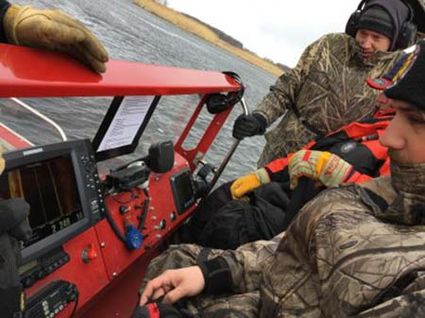SAR HAWK & Humminbird Soar with Hogansburg-Akwesasne Fire Department

HAVFD members Andrew Lazore and Cameron Mitchell train on the Humminbird – SAR HAWK sonar installed in the HAVFD airboats.
By Vince Capone
This article was originally published in the Black Laser Learning trade website.
April 12, 2018. One does not usually associate Humminbird Search & Rescue operations with the roar of counter rotating propellers being driven by a 475 horsepower V8 engine. The Hogansburg Akwesasne Volunteer Fire Department has not one, but two, highly versatile airboats both equipped with Humminbird side imaging sonars. Black Laser Learning's Vince Capone spent the weekend working with fire rescue personnel honing their Humminbird search skills.
Saturday's eight hours of classroom training focused on sonar theory and Humminbird image analysis as well as the advantages of post-mission data processing. The team also worked through Humminbird® controls in the warmth of the stations heated garage. Snow squalls did not prevent the team from practicing field ops on local rivers the next day.
After several hours on the water, the team went back to the station for data post processing. By using the SAR HAWK software, they reviewed sonar images on a large screen TV, providing a high resolution projection of the data not possible with the Humminbird unit alone.
The Humminbird units are mounted on the airboat's console with the transducer on a removable/retractable arm attached on the gunwale. The transducer needs to be retractable since the boats often travel over ice or marsh before having access to open water. Once on the water, the transducer is locked into place about 6 inches below the hull.
Search from an airboat is no different than from other platforms, other than the fan boats having access to very shallow water. As with any sonar search, a straight steady course is required for high quality bottom imagery. "I had never operated a Humminbird from an airboat and was surprised at the stability and steady course tracking provided by the platform," said Vince. "The pilots are masters of their craft and could hold a line as well as any standard surface craft."
After seeing it in action, the department decided to purchase SAR HAWK™ software, allowing the department to optimize their search CONOPS. The post processing software allows review of the data on high-resolution monitors under the controlled conditions of the command center while teams continue searching. In the future, the CON OPS will be for rotating teams to collect data and highlight any potential targets. For example, after searching for two hours, a team would hand data off to the command center for final review. The replacement team would continue searching while the command team could then determine coverage and locate possible targets for diver or ROY investigation. The
SAR HAWK software provides maximum flexibility in handling the Humminbird data for target investigation, contact reports or post mission coverage maps.
The Hogansburg Akwesasne Fire Department, founded in 1954, has a long, proud history of serving the communities of three nations. This department is the only team capable of winter water recoveries in the region. "They are highly engaged and friendly and I found training with this highly professional team a rewarding experience. It was a great weekend," Vince commented.
The Hogansburg Akwesasne Humminbird training was a cooperative effort of Dive Rescue International, Inc. and Black Laser Learning, Inc. We would like to extend a
hearty THANK YOU to the Hogansburg Akwesasne Volunteer Fire Department for hosting the event. A special thank you goes out to Mike Adams for making arrangements
and working through the logistics.







Reader Comments(0)